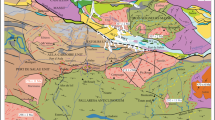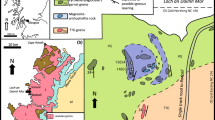Abstract.
Within the northern part of the early Archaean Itsaq Gneiss Complex (southern West Greenland) on the southern side of the Isua supracrustal belt, enclaves up to ~500 m long of variably altered ultramafic rocks contain some relics of unaltered dunite–harzburgite. These are associated with mafic supracrustal and plutonic rocks and siliceous metasediments. SHRIMP U/Pb zircon geochronology on non-igneous zircons in altered ultramafic rocks and on igneous zircons from components of the surrounding orthogneisses intruding them, indicate an absolute minimum age for the ultramafic rocks of ca. 3,650 Ma, but with an age of ca. 3,800 Ma most likely. The diverse ultramafic and mafic rocks with rarer metasediment were all first tectonically intercalated and then became enclosed in much more voluminous tonalitic rocks dated at ca. 3,800 Ma. This is interpreted to have occurred during the development of a 3,810–3,790-Ma composite magmatic arc early in the evolution of the Itsaq Gneiss Complex. This northern part of the Itsaq Gneiss Complex is the most favourable for the geochemical study of early Archaean protoliths because it experienced peak metamorphism only within the amphibolite facies with little or no in-situ melt segregation, and contains some areas that have undergone little deformation since ca. 3,800 Ma. Most of the ultramafic enclaves are thoroughly altered, and largely comprise secondary, hydrous phases. However, the centres of some enclaves have escaped alteration and comprise dunite and harzburgite with >95% olivine (Fo89–91) + orthopyroxene (En89) + Al-spinel (Cr8–20) assemblages. The dunites and harzburgites are massive or irregularly layered and are olivine-veined on 5–10-m to 10-cm scales. Their whole rock major and rare earth element, and olivine and spinel compositions differ significantly from xenoliths representing the Archaean cratonic lithospheric mantle, but are typical of some modern abyssal peridotites. The harzburgites and dunites show both LREE depleted and enriched patterns; however, none show the massive REE depletion associated with the modelled removal of a komatiite. They are interpreted as being the products of small degrees of melt extraction, with some showing evidence of refertilisation. These Greenland dunites and harzburgites described here are currently the best characterised 'sample' of the early Archaean upper mantle.
Similar content being viewed by others
Author information
Authors and Affiliations
Additional information
Electronic Publication
Rights and permissions
About this article
Cite this article
Friend, .C., Bennett, .V. & Nutman, .A. Abyssal peridotites >3,800 Ma from southern West Greenland: field relationships, petrography, geochronology, whole-rock and mineral chemistry of dunite and harzburgite inclusions in the Itsaq Gneiss Complex. Contrib Mineral Petrol 143, 71–92 (2002). https://doi.org/10.1007/s00410-001-0332-7
Received:
Accepted:
Issue Date:
DOI: https://doi.org/10.1007/s00410-001-0332-7




